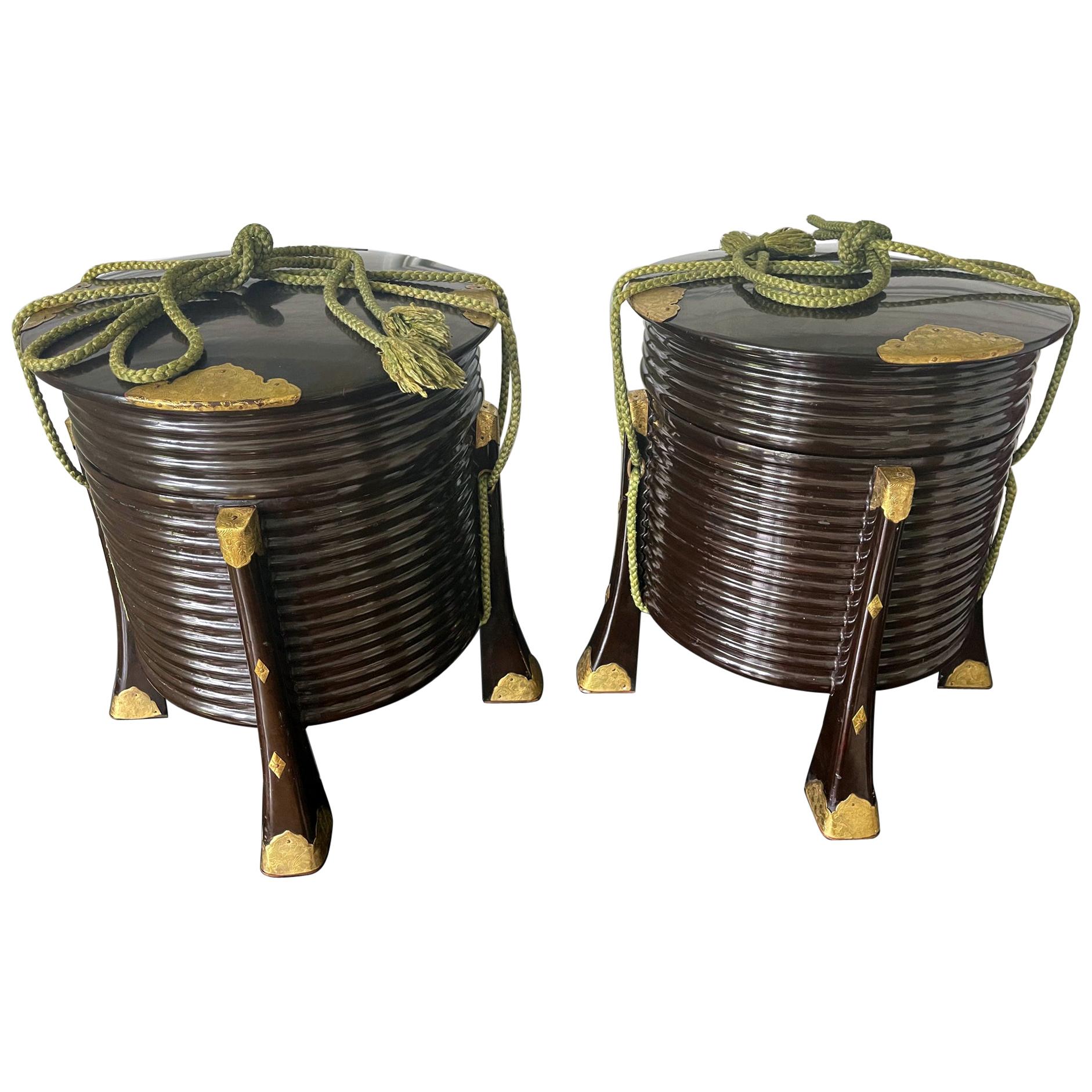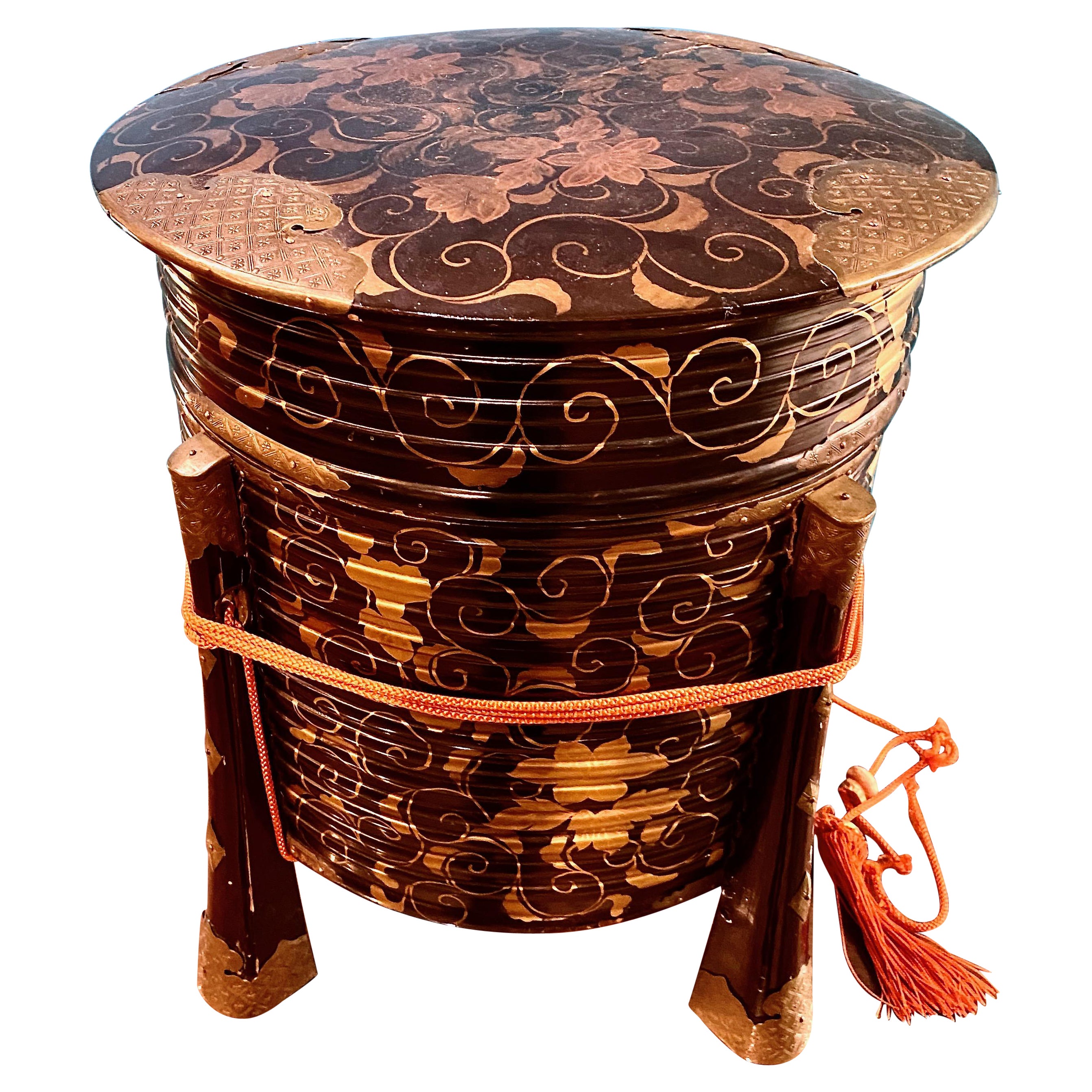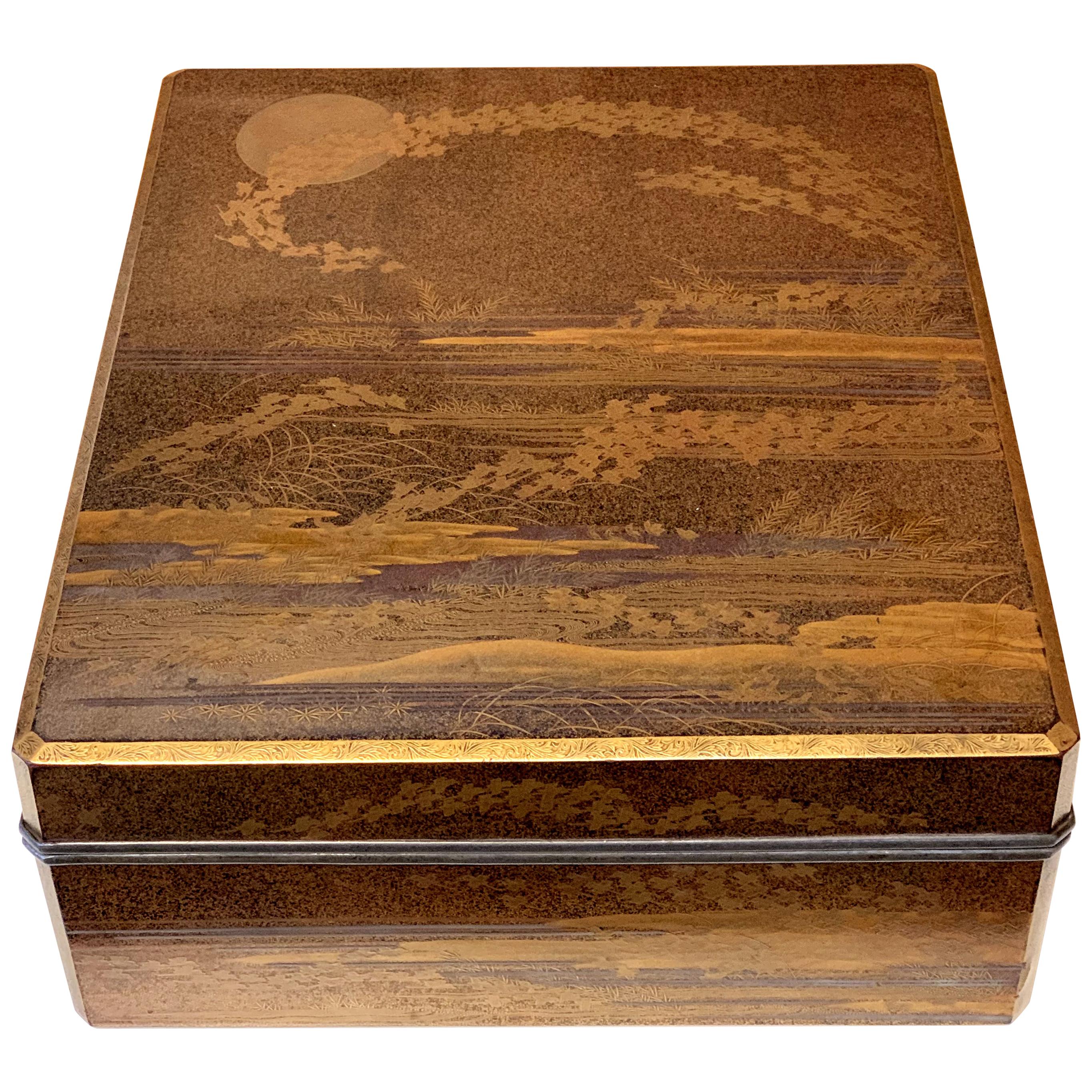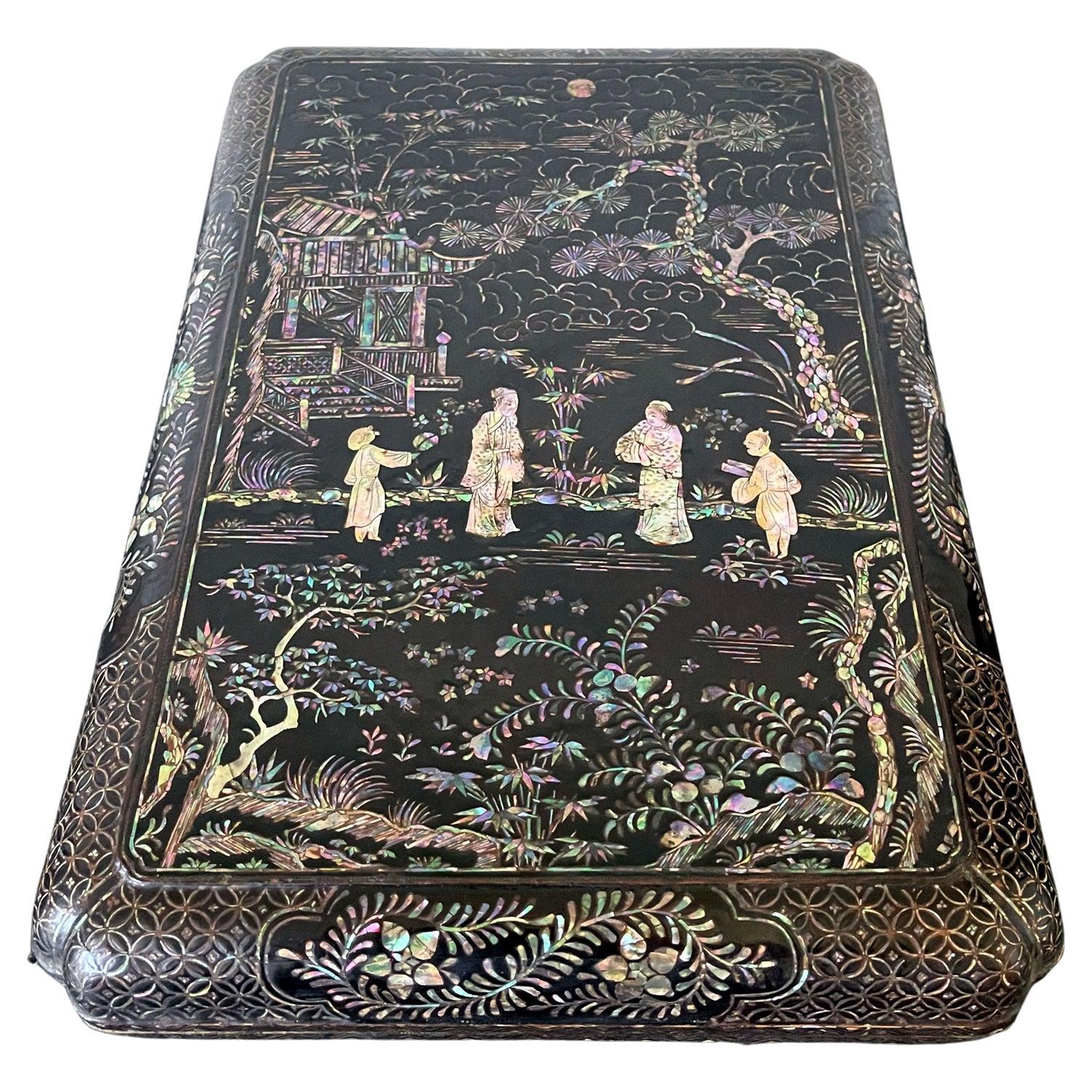Items Similar to Pair of Large Antique Japanese Hokai Lacquer Boxes
Want more images or videos?
Request additional images or videos from the seller
1 of 20
Pair of Large Antique Japanese Hokai Lacquer Boxes
About the Item
A pair of Japanese lacquered lidded Hokai boxes with chased brass hardware and original ropes. Hokai boxes are traditionally used in Japan as the containers to store and carry shells for Kai-awase game in Edo and Meiji Period. Always in pair for the nature of the game, that is to find the matching halves of the shells, these storage containers with lids are fashioned in dark brown-black lacquer, supported by four slightly out-turned legs and decorated with elaborately engraved brass fittings. This pair will add a bespoken touch to any modern interior space due to the minimal exterior surface decoration.
Well preserved from the Meiji-Taisho period circa early part of 20th century, the boxes still retain the original orange ropes and a paper sticker inside with Kanji inscription.
- Dimensions:Height: 18.5 in (46.99 cm)Diameter: 16 in (40.64 cm)
- Sold As:Set of 2
- Style:Japonisme (Of the Period)
- Materials and Techniques:
- Place of Origin:
- Period:
- Date of Manufacture:Early 20th Century
- Condition:Wear consistent with age and use. Good overall condition. Expected scattered surface patina such as scratches, scrapes indentations and chips, some with touchups throughout. May be hard to see due to the reflective surface. Brass with patina. Ropes are worn faded.
- Seller Location:Atlanta, GA
- Reference Number:1stDibs: LU945029486612
About the Seller
5.0
Platinum Seller
These expertly vetted sellers are 1stDibs' most experienced sellers and are rated highest by our customers.
Established in 2006
1stDibs seller since 2010
479 sales on 1stDibs
Typical response time: <1 hour
- ShippingRetrieving quote...Ships From: Atlanta, GA
- Return PolicyA return for this item may be initiated within 2 days of delivery.
More From This SellerView All
- Pair of Large Antique Japanese Hokai Lacquer BoxesLocated in Atlanta, GAA pair of Japanese lacquer lidded Hokai boxes with chased brass hardware and original ropes. Hokai boxes are traditionally used in Japan to store and carry s...Category
Early 20th Century Japanese Japonisme Lacquer
MaterialsWood, Lacquer
- Antique Japanese Lacquered Incense Box Kobako Ex-Christie'sLocated in Atlanta, GAAn old Japanese lacquered small box likely used to contain incense powder called Kobako, circa Momoyama to early Edo period (16-17th century). The rectangular form box with a fitted ...Category
Antique 17th Century Japanese Japonisme Lacquer
MaterialsLead
- Large Japanese Lacquer Box Early Edo Period Ex-Christie'sLocated in Atlanta, GAA large lacquer Ryoshibako (Paper box in Japanese) finely decorated with Maki-e circa 17th century early Edo period. The box is of an impressive size and was used to store paper documents. Both sides of the lid were elaborately decorated with maki-e and the edge was befitted with lead rim, an early practice before the silver rim became common later. The interior and base were finished in Nashiji. The night scene on top surface of the lid depicts flocks of chidoris flying in formation from a sea shore swaying with reeds under a full moon, using hiramaki-e in both gold and silver. Ribbons of clouds were achieved with different densities of gold powder. The underside, in contrast, shows a crescent moon in takamakie-e above the sea with ferns and reeds. Chidoris, the plovers, are symbolic in Japanese culture as "thousands of blessings" and longevity. The Namichidori, the pattern in which the chidori flies in the nami (wave) represents the eternal love and safety of couples and families. For detailed references on the historical background and the use of chidoris on lacquerware, see the reference below. This very lacquer box was featured for sale as lot 339 in Christie's London Sale Japanese Art...Category
Antique 17th Century Japanese Japonisme Lacquer
MaterialsWood, Lacquer
- Antique Japanese Lacquer and Inlay Box from Ryukyu IslandLocated in Atlanta, GAA lacquer presentation box with mother-of-pearl inlays from Japanese Ryukyu Islands circa 17-18th century. The lidded box in rectangular form with rounded corner is a classic example...Category
Antique 18th Century Japanese Japonisme Lacquer
MaterialsMother-of-Pearl, Lacquer
- Japanese Maki-e Lacquer Stack Box JubakoLocated in Atlanta, GAAn antique jubako (stack boxes) with five tiers in an elongated octagon shape circa 19th century (end of Edo or beginning of Meiji period). jubako was traditionally used to store and...Category
Antique 19th Century Japanese Japonisme Lacquer
MaterialsWood, Lacquer
- Japanese Rinpa Style Lacquer Box Meiji PeriodLocated in Atlanta, GAA black lacquer tebako (hand box) with maki-e decoration and silver trim, circa late 19th century, Meiji period. The surface of the lid features a Rinpa style maki-e paint depicting ...Category
Antique 1890s Japanese Japonisme Lacquer
MaterialsWood, Lacquer
You May Also Like
- Japanese Lacquer Hokai Box, 19th CenturyLocated in Pasadena, CAThis is a good example of a traditional Japanese Hokai shell storage box for the Kai-awase game. This box is well-detailed in chased brass appliques and makie. The box is in overall ...Category
Antique Late 19th Century Japanese Japonisme Lacquer
MaterialsWood, Lacquer
- Japanese Lacquer BoxLocated in New York, NYA Japanese red burgundy, gold and black lacquer box with round corners and silk cloth interior lining, circa early-20th century, 1920s, Japan. Box was desi...Category
Early 20th Century Japanese Decorative Boxes
MaterialsWood, Silk
- Antique Japanese Lacquer Stacking Food Box 'Jubako'Located in Hudson, NYWith all-over mother of pearl inlay and mon design of chrysanthemum in gold and black lacquer on top. The chrysanthemum is a national symbol of Japan and the Imperial family.Category
Antique 19th Century Japanese Lacquer
MaterialsGold
- Japanese Lacquered Tebako 'Box'Located in PARIS, FRTebako box with three compartments in golden and nashi-ji lacquer, decorated with golden, red, and kirigane lacquer, golden persimmon tree leaves, among rocks. The compartments are of increasing size from the top. The decoration is in continuity. Persimmon has been cultivated in southern China for more than 2500 years and is believed to have been introduced to Japan in the 8th century. The veneer is a tree with very hard wood, similar to ebony. According to a legend, one specimen survived the atomic bombing of Nagasaki on August 9, 1945, close to the epicenter. It is therefore in Japan a symbol of strength and longevity. It is also the national fruit of the country. It is eaten as a traditional dish during New Year's Day celebrations. Tebako literally means "portable box...Category
Antique 1860s Japanese Lacquer
MaterialsLacquer
- Japanese Lacquered Furoshiki Kobako 'Box'Located in PARIS, FRRectangular and flat lacquer Kobako (small box) representing a furoshiki knot seen from above. Fundame background, furoshiki in takamaki-e with floral pattern, inside the folds of the fabric with black and gold sayagata pattern with togidashi maki-e technique. The saya (or sayagata) pattern is composed of Chinese swastikas...Category
Antique Late 19th Century Japanese Lacquer
MaterialsLacquer
- Japanese Lacquered Natsume 'Tea Box'Located in PARIS, FRNatsume in dark red lacquer, decorated with autumn leaves and cherry blossoms in hiramaki-e and nashiji. Interior in black lacquer. Maple leaves (Momiji) are celebrated in literatur...Category
Mid-20th Century Japanese Lacquer
MaterialsLacquer
Recently Viewed
View AllMore Ways To Browse
Modern Lacquer
Brown Lacquer
Lacquered Brass
Pair Lacquer
Pair Of Lacquer
Black Lacquer Brass Furniture
Black Lacquer Brass
Black Lacquer And Brass
Black Lacquered And Brass
Large Japanese Art
Black Lacquer Storage
Large Art Pair
Large Pair Of Art
Pair Black Lacquer
Antique Art Pairs
Lacquer Box
Lacquered Box
Japanese 20th Century Modern Furniture





